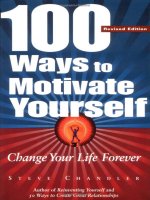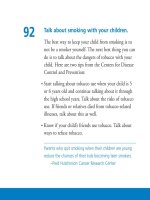Feeling good 100 ways to feel better every day phần 5 docx
Bạn đang xem bản rút gọn của tài liệu. Xem và tải ngay bản đầy đủ của tài liệu tại đây (63.98 KB, 11 trang )
Set work/home boundaries.
It’s important to try to leave work behind when your
workday has ended. Here are four tips:
• Use an answering machine, voicemail, or caller ID to
screen your calls. Turn off your cell phone.
• Prioritize enjoying your time.
• Give yourself a few minutes to “switch gears” when
you get home. Change your clothes, eat a snack, or
do something else that marks the end of the workday
and the beginning of the rest of your day before you
jump into your home routine.
• Plan activities at home or with friends and family that
will add balance to your day.
50
Take steps to avoid burnout.
If you work long hours and are doing way too much,
you may be a candidate for burnout—which is the
opposite of feeling good. The signs of burnout
include headaches, exhaustion, lack of enthusiasm,
loss of interest in sex, heart palpitations, feeling
irritable, and having no time for family and friends. If
you are feeling burned out, it’s important to make
some positive changes in your life. Burnout can affect
your health and your personal life.
• Get the support you need to balance work/life issues.
Ask your manager for help and support. Or contact
your EAP or employee resource program.
• Talk with your health care provider about your
concerns.
• Force yourself to take daily “mini-vacations.” Go for a
walk at lunchtime. Or take time out of your busy day
to meditate.
51
Get professional help if problems persist.
If you are facing a problem you can’t solve on your
own, talk with a professional.
• If you have concerns about your child, talk with the
school guidance counselor or your child’s pediatrician
or your EAP.
• If you are caring for a grandchild or an older relative,
contact a support group or your EAP or employee
resource program.
• If you could use help with a gambling problem, a
shopping addiction, a relationship problem, or
another personal concern, talk with your doctor, a
therapist, or your EAP or employee resource program.
• Seek spiritual guidance through your faith
community.
52
Pay attention to your posture.
Proper posture, especially if you sit and work from a
chair for long stretches, is essential for good health.
• Adjust the height of your chair to minimize strain on
your legs and back. Your feet should rest flat on the
floor or a footrest and your thighs should be parallel
to the floor.
• Be sure your chair has good back support. Sit upright
in the chair with your lower back against the backrest.
• Don’t slouch, sit hunched over, or sit cross-legged
when you work. Don’t use armrests to slouch.
• Take breaks from the computer every 20 to 40
minutes in order for your body to rest and recover.
Working at the computer is very fatiguing on your
upper body as well as your eyes. It’s important to
get up and move around. Do tasks that aren’t
computer-related.
53
54
Protect your back.
What do you think is the most effective way to help
prevent episodes of back pain? Getting regular
exercise, sleeping on a firm mattress, or carrying your
briefcase as a backpack instead of on your shoulder?
The answer, according to the American Academy of
Physical Medicine and Rehabilitation, is getting
regular exercise. Proper exercise can help strengthen
back and abdominal muscles and help you avoid back
injury. Talk with your health care provider about
exercises that are right for you.
Six out of ten students ages 9 to 20 reported chronic
back pain related to heavy backpacks, according to the
American Occupational Therapy Association. To prevent
injury, make sure your child wears both straps, tightens the
straps so that the backpack fits close to the body, and
carries no more than 10 to 15 percent of his total body
weight in the pack.
Get help for headaches.
If headaches keep you from going to work or are
affecting your personal life, get help.
• Make an appointment to see your health care provider
for an accurate diagnosis. Become informed about
your headache type and treatment options.
• To help with occasional tension headaches, try a
warm shower, rest, or relaxation techniques.
• Some headaches are caused by dehydration. Many
physicians recommend that you drink at least 8
ounces of water or a sports drink at the onset of a
headache. If you have a chronic medical condition,
clear this first with your physician.
Headaches affect millions of people and cost companies
billions of dollars a year in lost productivity, absenteeism,
and medical expenses, according to the National Headache
Foundation.
55
Get help for chronic pain.
More than half of all Americans suffered chronic or
recurrent pain in the last year, according to a recent
poll by Research!America, a not-for-profit advocacy
group. And more than three in five chronic pain
sufferers have been in pain for more than a year. Back
pain is at the top of the list, followed by arthritis and
joint pain, knee pain, headaches, and shoulder pain.
People 18 to 34 are about as likely to experience
chronic pain as older people.
The best way to get help for chronic pain is to
acknowledge your pain, take it seriously, and find a
doctor who takes your pain seriously, too. If your
doctor is unable or unwilling to treat your pain, talk
to another doctor.
56
Plan something to look forward to.
Plan things to look forward to and you’ll always be
looking ahead with optimism. Plan to meet a friend
next week or month for lunch, dinner, or a movie.
Plan a fun family trip for next summer. Plan a way to
celebrate an upcoming holiday or special occasion
with the people you love. Plan a play date with your
child. Plan to hike a mountain you’ve always dreamed
of climbing, or to visit an old friend or niece or
grandchild you don’t see enough.
Feeling good takes planning and forethought. But
when you plan things to look forward to, even the
anticipation feels good.
57
Be there for a friend.
Friends can be the best support system of all. Here
are some simple ways to be there for a friend:
• Donate your time. Uninterrupted listening time,
whether in person or over the phone, is one of the
best gifts you can give a friend.
• Be a reminder of positive things.
• Send a card, e-mail, text message, or leave a voicemail
message letting your friend know you’re thinking
about him or her.
• Offer to run errands or care for family members to
allow your friend some time to relax.
• Visit in person when possible if a friend is ill or
in need.
58
Make time for intimacy.
An intimate relationship is one of life’s greatest
pleasures. But it also takes some planning and work.
We all need to make being together a priority.
Otherwise, everything from doing the laundry to
paying the bills can get in the way of spending
time together.
• Make time for intimacy. Some people carve out a
“date night.” Others plan a night away from home
and familiar routines.
• Do things together that bring you close and awaken
feelings of intimacy. Have breakfast in bed together.
Take an afternoon nap together. Take a swim together.
Give each other massages and back rubs.
• Be affectionate. How often do you and your partner
kiss and hug one another?
59
Touch someone you love.
Physical touch does so many wonderful things. It
relaxes, calms, promotes better sleep, and makes you
and the person you love feel good all over. Touch the
people you love.
• Hug your child, teenager, parent, grandparent, cousin,
partner, and friend.
• Spend more time snuggling.
• Give hello and goodbye kisses to the people you love.
• Teach your children to express caring and affection
through physical touch.
60









